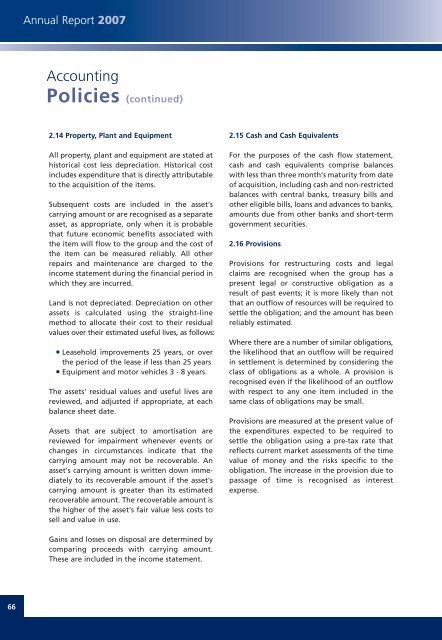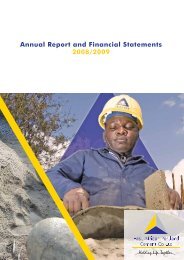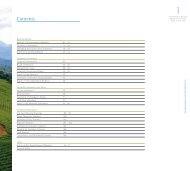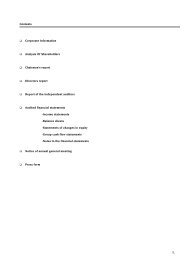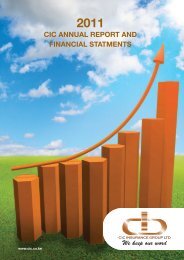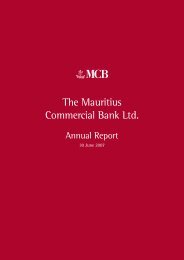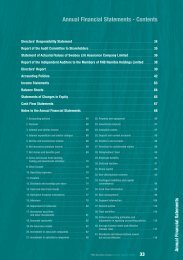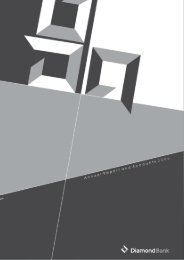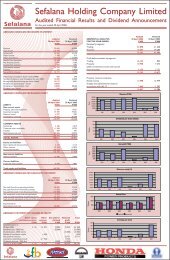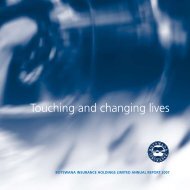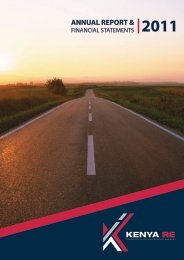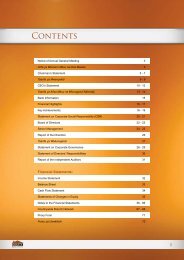Annual Report 2007 - Investing In Africa
Annual Report 2007 - Investing In Africa
Annual Report 2007 - Investing In Africa
Create successful ePaper yourself
Turn your PDF publications into a flip-book with our unique Google optimized e-Paper software.
<strong>Annual</strong> <strong>Report</strong> <strong>2007</strong><br />
Accounting<br />
Policies (continued)<br />
2.14 Property, Plant and Equipment<br />
All property, plant and equipment are stated at<br />
historical cost less depreciation. Historical cost<br />
includes expenditure that is directly attributable<br />
to the acquisition of the items.<br />
Subsequent costs are included in the asset's<br />
carrying amount or are recognised as a separate<br />
asset, as appropriate, only when it is probable<br />
that future economic benefits associated with<br />
the item will flow to the group and the cost of<br />
the item can be measured reliably. All other<br />
repairs and maintenance are charged to the<br />
income statement during the financial period in<br />
which they are incurred.<br />
Land is not depreciated. Depreciation on other<br />
assets is calculated using the straight-line<br />
method to allocate their cost to their residual<br />
values over their estimated useful lives, as follows:<br />
Leasehold improvements 25 years, or over<br />
the period of the lease if less than 25 years<br />
Equipment and motor vehicles 3 - 8 years.<br />
The assets' residual values and useful lives are<br />
reviewed, and adjusted if appropriate, at each<br />
balance sheet date.<br />
Assets that are subject to amortisation are<br />
reviewed for impairment whenever events or<br />
changes in circumstances indicate that the<br />
carrying amount may not be recoverable. An<br />
asset's carrying amount is written down immediately<br />
to its recoverable amount if the asset's<br />
carrying amount is greater than its estimated<br />
recoverable amount. The recoverable amount is<br />
the higher of the asset's fair value less costs to<br />
sell and value in use.<br />
2.15 Cash and Cash Equivalents<br />
For the purposes of the cash flow statement,<br />
cash and cash equivalents comprise balances<br />
with less than three month's maturity from date<br />
of acquisition, including cash and non-restricted<br />
balances with central banks, treasury bills and<br />
other eligible bills, loans and advances to banks,<br />
amounts due from other banks and short-term<br />
government securities.<br />
2.16 Provisions<br />
Provisions for restructuring costs and legal<br />
claims are recognised when the group has a<br />
present legal or constructive obligation as a<br />
result of past events; it is more likely than not<br />
that an outflow of resources will be required to<br />
settle the obligation; and the amount has been<br />
reliably estimated.<br />
Where there are a number of similar obligations,<br />
the likelihood that an outflow will be required<br />
in settlement is determined by considering the<br />
class of obligations as a whole. A provision is<br />
recognised even if the likelihood of an outflow<br />
with respect to any one item included in the<br />
same class of obligations may be small.<br />
Provisions are measured at the present value of<br />
the expenditures expected to be required to<br />
settle the obligation using a pre-tax rate that<br />
reflects current market assessments of the time<br />
value of money and the risks specific to the<br />
obligation. The increase in the provision due to<br />
passage of time is recognised as interest<br />
expense.<br />
Gains and losses on disposal are determined by<br />
comparing proceeds with carrying amount.<br />
These are included in the income statement.<br />
66


